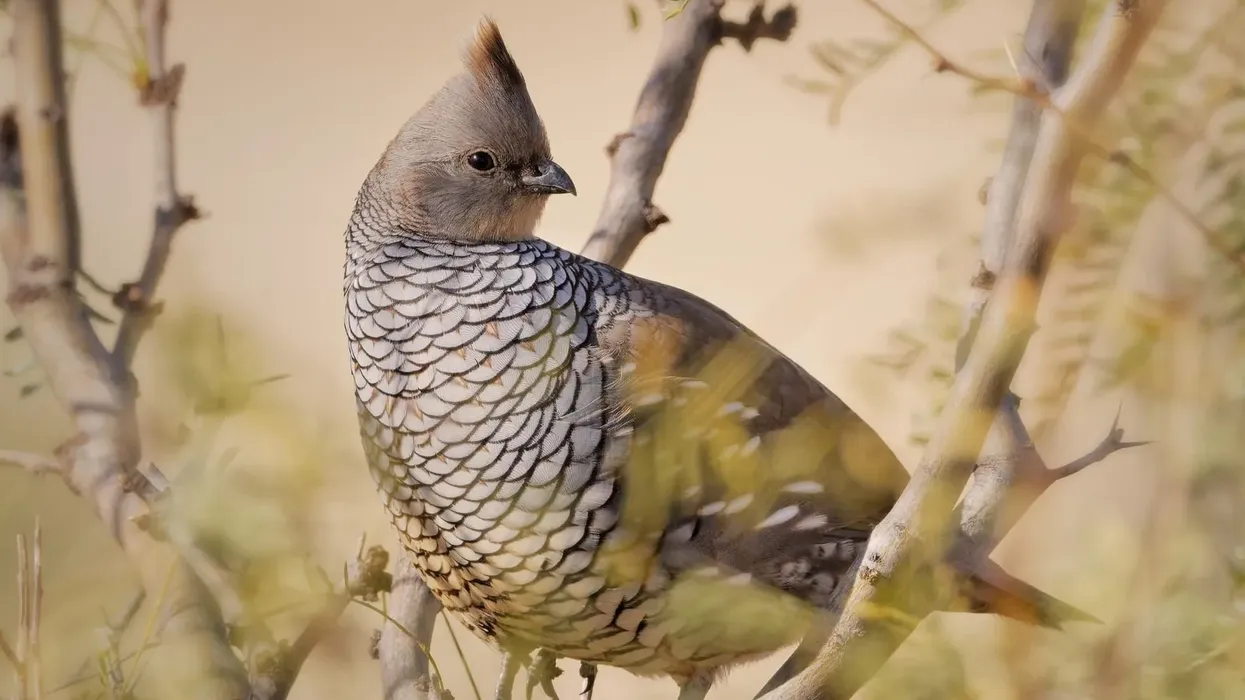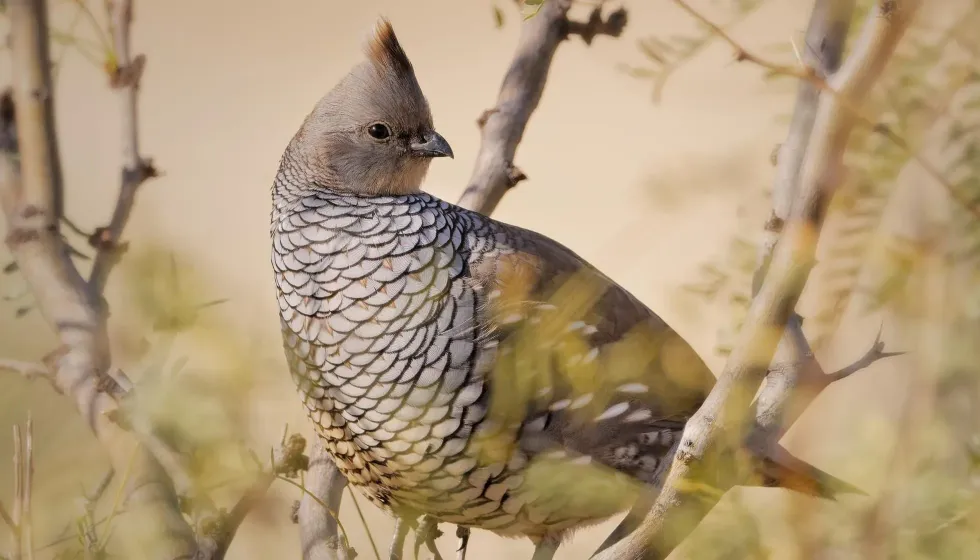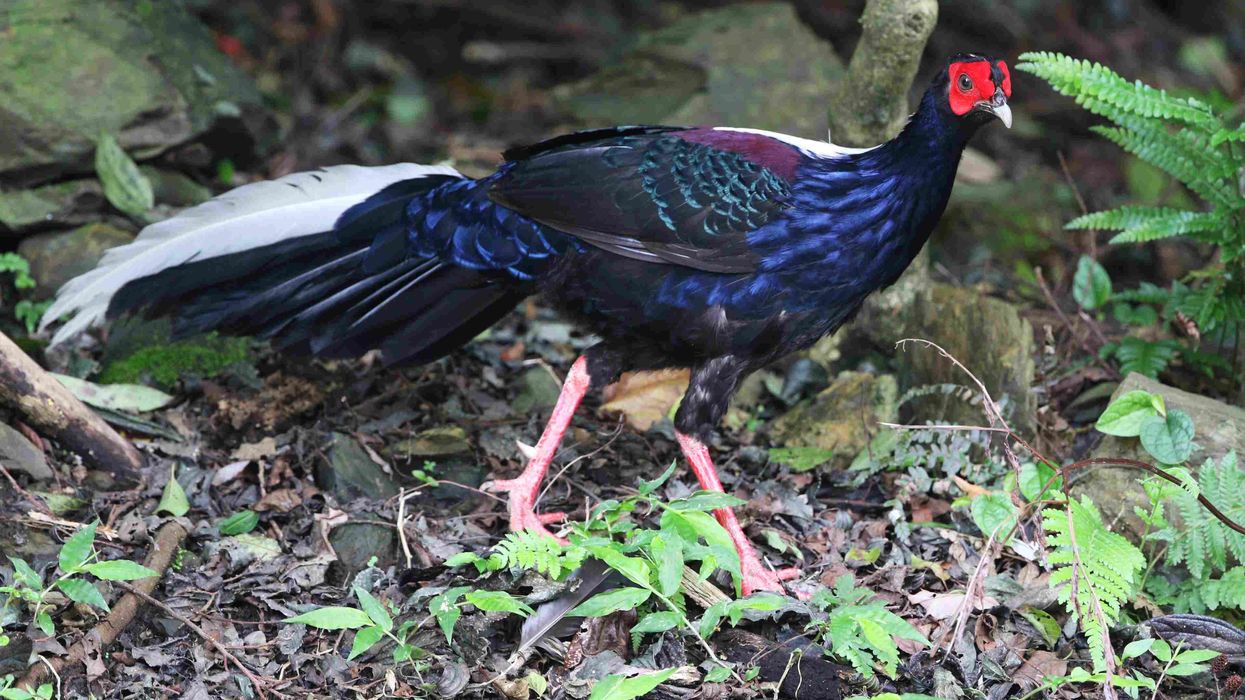The scaled quail (Callipepla squamata), also called a blue quail or cottontop, is a North American quail species found in the southwestern United States. They may range from northern New Mexico, Texas, Arizona to Colorado and Sonora. They belong to the order galliformes, family Odontophoridae and genus Callipepla.
The scaled quail habitat preferences range from desert grasslands to sparsely vegetated scrublands. These North American birds go foraging on the ground in early morning or late evening. Their diet is omnivorous and includes seeds, grass, fruits as well as insects.
This quail tend to feed around shrubs or grass clumps they can use for cover and protection from hunting. Scaled quails can be identified by their blueish gray plumage and scaly pattern.
The prominent crest is tipped in white, which gives them the cottontop name. The nest is usually build on the ground or near shrubs by both males and females.
The call of a scaled quail is hoarse, high-pitched and often heard in early mornings.
The conservation status of this bird species is Least Concern and the numbers are ample, making them the second most hunted quail after the northern bobwhite. If you enjoyed reading about the scaled quail, you can also read about the Tawny Eagle and the Gouldian Finch.
Scaled Quail Interesting Facts
What type of animal is a scaled quail?
The scaled quail (Callipepla squamata) is a species of North American birds commonly found in grasslands of southwestern United States. The distribution of these birds may range from northern New Mexico, Texas to Colorado and Arizona.
What class of animal does a scaled quail belong to?
The common quail belongs to the class of birds from the order galliformes, family Odontophoridae and the Callipepla genus. The scientific name of this quail species is Callipepla squamata.
How many scaled quails are there in the world?
There are about five million scaled quails in the world. As a bird species with a Least Concern conservation status, they are fairly common and present abundantly. In recent years, the scaled quail populations are observing a steady decrease due to loss of habitat and diseases.
Where does a scaled quail live?
The North American scaled quail usually lives in desert grasslands of southwestern United States. Their habitat can range from northern New Mexico, Arizona, Colorado, northern west Texas and Sonora. The main habitat requirement for this quail species is food and cover.
What is a scaled quail's habitat?
The scaled quail is most commonly found in mixed habitats like arid, desert grasslands and sparsely vegetated scrublands with a steady food source. These birds can also be found in open plains, gullies, rocky slopes, foothills, and hills rich in acacia, yucca, cholla and sagebrush.
Quails prefer open ground near to cover or a structure they can use to hide in and tend to avoid areas with dense growth.
Who do scaled quails live with?
Scaled quails tend to live in small groups with birds of the same species. During the breeding season, this bird can be seen in pairs and with their chicks.
How long does a scaled quail live?
The average lifespan of a scaled quail, or Callipepla squamata, is about one year. They have a high mortality rate due to predators and rarely die of old age.
How do they reproduce?
The breeding season of the scaled quail can begin in early April or early October with a significant peak in June. One of the major factor that effects nesting is availability of food and precipitation.
Spring and summer droughts in desert grasslands may also affect nesting. Both males and females build a shallow nest on the ground or shrubs.
This nest is made up of bunchgrass, yucca, Russian thistle and threeawns. Males perch on shrubs or rocks and give a hoarse scaled quail call for breeding females.
After mating, females can lay about 9-16 eggs and have generally more eggs in August season. The incubation period can take up to 23 days and both male as well as female birds raise the young ones.
What is their conservation status?
The conservation status of the scaled blue quail is Least Concern, which means their numbers are still abundant. These birds have become a major victim to habitat loss and predation. Due to this, the scaled quail populations have been decreasing.
Scaled Quail Fun Facts
What do scaled quails look like?
The scaled quail, as the name suggests, has a fish-like scaly intricate pattern on their necks with a buffy crest top. They are bluish gray and both sexes have similar appearances but can be differentiated.
Males have a cream throat, while it is brown for females. The top of the crest is tipped in white, and they have a short tail and short legs.

How cute are they?
Scaled quails have an interesting fish-like, blueish gray scaly pattern on their breast and have a cute cotton-tipped crest. Overall, these birds look very exotic and are a cute wildlife bird species!
How do they communicate?
The scaled quail usually communicates using vocal cues like chirping, tweeting and other body language signs. The scaled quail sound or chirp is very hoarse or high-pitched wock usually heard in early morning.
How big is a scaled quail?
The scaled quail's height can range from 10.0-12.0 in (25.4-30.5 cm) with a wingspan of 15.0 in (38 cm). It is slightly larger than a Northern bobwhite bird and about 3 times the size of a hummingbird.
How fast can a scaled quail run?
There are no studies that have calculated the speed of a scaled quail.
How much does a scaled quail weigh?
The average weight of a scaled quail can range from 6.2-6.7 oz (177-191 g).
What are the male and female names of the species?
A male scaled quail is known as a roo or cock while a female is called a hen. A flock of quails is known as a covey.
What would you call a baby scaled quail?
A scaled quail baby is called a chick, juvenile, young or a fledging.
What do they eat?
The scaled quail can feed on seeds, fruits, leafy grass and insects. Their main preferences are allthorn, catclaw mimosa, desert olive, paspalum, wheat, pricklepoppy, thistles, and sunflower. Insects they feed on include caterpillars, beetles, grasshoppers and ants. The main predators of these birds are gray fox, raccoons, red-tailed hawks, coyotes and red fox.
Are they poisonous?
The scaled quail is not a poisonous or harmful bird species and does not often interact with humans.
Would they make a good pet?
None of the bird species make a particularly good pet, unless properly trained. Scaled quails are also not a good pet as they belong in the sky or in the wildlife.
Did you know...
Most female scaled quails are monogamous while others are known to perform double brooding, where they nest twice and lay two clutches of eggs from different males.
Do scaled quails migrate?
Scaled quails are not exactly a migratory bird species, but they do travel long distances in during summer, that is, March to April. The unusual movements of this bird does not have a set pattern and they may travel a wide range of 1-5 miles (1.6-8 km).
The maximum distance was 54 miles (87 km), recorded from a scaled quail in Mexico.
How long do blue-scaled quail eggs take to hatch?
The incubation period of a scaled quail can take up to 23 days and both males or females help in incubating. The hatch rates of this bird are not that high due to abundance of predators in the nesting season.
The quails mate only if the vegetation cover is enough and there are no signs of a drought. They may even postpone breeding altogether if conditions are not favourable.
Here at Kidadl, we have carefully created lots of interesting family-friendly animal facts for everyone to discover! For more relatable content, check out these Grey Partridge facts and Song thrush facts for kids.
You can even occupy yourself at home by drawing one on our Scaled Quail coloring pages.










